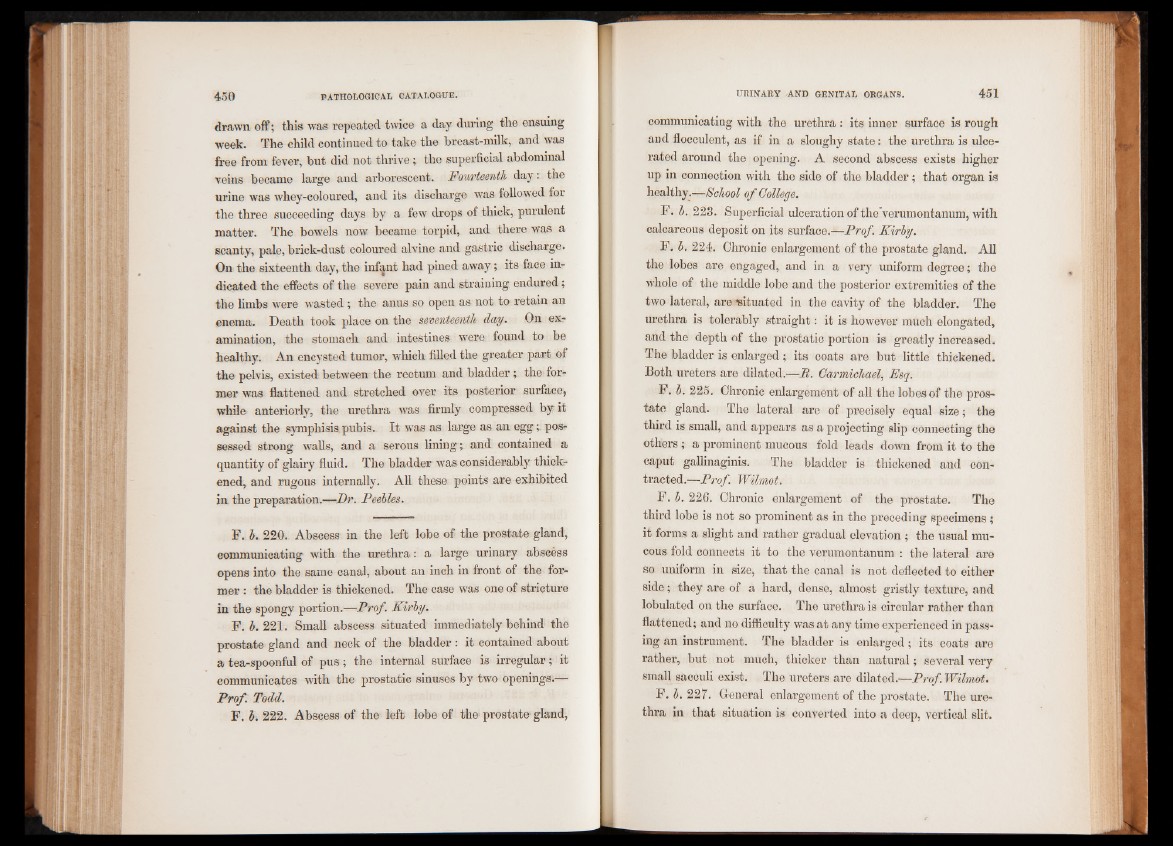
drawn off; this was repeated twice a day during the ensuing
week. The child continued to take the breast-milk, and was
free from fever, but did not thrive; the superficial abdominal
veins became large and arborescent. Fourteenth day: the
urine was whey-coloured, and its discharge was followed for
the three succeeding days by a few drops of thick, purulent
matter. The bowels now became torpid, and there was a
scanty, pale, brick-dust coloured alvine and gastric discharge.
On the sixteenth day, the infant had pined away; its face indicated
the effects of the severe pain and straining endured;
the limbs were wasted; the anus so open as not to retain an
enema. Death took place on the seventeenth day. On examination,
the stomach and intestines were found to be
healthy. An encysted tumor, which filled the greater part of
the pelvis, existed between the rectum and bladder; the- former
was flattened and stretched over its posterior surface,
while anteriorly, the urethra was firmly compressed by it
against the symphisis, pubis. It was as large as an eggpossessed
strong walls, and a serous lining ; and contained a
quantity of glairy fluid. The bladder was considerably thickened,
and rugous internally. All these points are exhibited
in the preparation.—Dr. Peebles.
F. 1. 220. Abscess in the left lobe of the prostate gland,
communicating with the urethra: a large urinary abscess
opens into the same canal, about an inch in front of the former
: the bladder is thickened. The case was one of stricture
in the spongy portion.—Prof. Kirby.
F. b. 221. Small abscess situated immediately behind the
prostate gland and neck of the bladder : it contained about
a tea-spoonful of pus; the internal surface is irregular; it
communicates with the prostatic sinuses by two openings.—
Prof. Todd.
F. b. 222. Abscess of the left lobe of the prostate gland,
communicating with the urethra : its inner surface is rough
and flocculent, as if in a sloughy state: the urethra is ulcerated
around the opening. A second abscess exists higher
up in connection with the side of the bladder; that organ is
healthy.—School of College.
F. b. 223. Superficial ulceration of the’verumontanum, with
calcareous deposit on its surface.—Prof. Kirby.
F. b. 224. Chronic enlargement of the prostate gland. All
the lobes are engaged, and in a very uniform degree; the
whole of the middle lobe and the posterior extremities of the
two lateral, are «situated in the cavity of the bladder. The
urethra is tolerably straight: it is however much elongated,
and the depth of the prostatic portion is greatly increased.
The bladder is enlarged; its coats are but little thickened.
Both ureters are dilated.—R. Carmichael, Esq.
F. b. 225, Chronic enlargement of all the lobes of the prostate
gland. The lateral are of precisely equal size; the
third is small, and appears as a projecting slip connecting the
others; a prominent mucous fold leads down from it to the
caput gallinaginis. The bladder is thickened and contracted.—
Prof. Wilmot.
F. b. 226. Chronic enlargement of the prostate. The
third lobe is not so prominent as in the preceding specimens;
it forms a slight and rather gradual elevation ; the usual mucous
fold connects it to the verumontanum : the lateral are
so uniform in size, that the canal is not deflected to either
side; they are of a hard, dense, almost gristly texture, and
lobulated on the surface. The urethra is circular rather than
flattened; and no difficulty was at any time experienced in passing
an instrument. The bladder is enlarged; its coats are
rather, but not much, thicker than natural; several very
small sacculi exist. The ureters are dilated.—Prof. Wilmot.
F. b. 227. General enlargement of the prostate. The urethra
in that situation is converted into a deep, vertical slit.